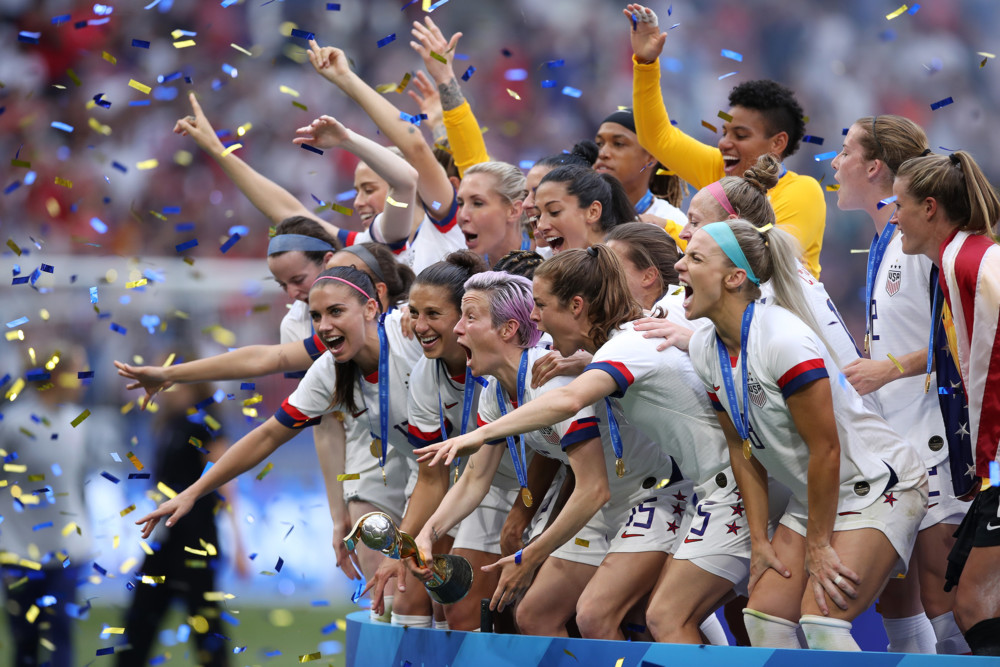By J. Levi Burnfin
The Garden City Telegram, Kan.
WWR Article Summary (tl;dr) As J. Levi Burnfin points out, “Women like Rapinoe, and Hamm, and Chastain, and countless others have brought women’s soccer so far, not only in this country but worldwide as countries in Europe and Asia have also gotten serious about women’s soccer thanks to American women leading the way.”
The Garden City Telegram, Kan.
“I believe that we will be four-time champions and keep winning until we not only become the best female soccer team, but the best soccer team in the world. And that a whole generation of girls and boys will go out and play and say things like, ‘I want to be like Megan Rapinoe when I grow up.’ ”
Chills.
That was the script in Nike’s stellar commercial following the U.S. National Team’s — yes, the national team, not the women’s national team — World Cup win on Sunday. It began with the well-known “I believe” chant that is used by the national teams’ fans, and then took a turn into that monologue, which is a hat tip to not only where women’s soccer is going in this country, but how far it’s come.
Nearly 50 years ago, Title IX was implemented, and for the first time women were given a real chance to compete at the high school and collegiate levels.
buy avana generic buy avana online no prescription
Count the four stars on the chest of the women’s national team as a direct result of that groundbreaking legislation.
And count several of my dearest sporting memories as a pleasant byproduct of it, as well.
Take 2015, for one.
“She scored!” my wife yelled from the living room.
“What?!” I said back. How could that be?
I had miss-timed finishing cooking dinner by a bit, but it was a soccer match — how much would I miss if I was a few minutes late to sitting down to watch?
Well, it was the 2015 World Cup final — if you remember that game, you know I ended up missing a lot. By the time I had plated everything and was sitting down to eat with my wife and newborn son, I had missed three U.S. goals in 14 minutes.
Thankfully, I was just in time for the outstanding Carli Lloyd goal from midfield, chipping the goalkeeper and clanking it in off the post. The U.S. would go on to win that World Cup Final, 5-2, in dominant fashion over Japan, and followed that up with a 2-0 win over the Netherlands on Sunday for the back-to-back titles and the fourth overall.
One of my earliest memories was Brandi Chastain’s indelible celebration as her penalty hit the back of the net against China in 1999 to win the U.S. women their second World Cup. It was magic.
It was also exactly the type of memory Nike was referring to.
I was a 10-year-old boy, but Chastain and Mia Hamm and Briana Scurry and Michelle Akers were heroes to me then and now.
“I want to be like Megan Rapinoe when I grow up.”
I know that’s true for many — girls and boys — after Sunday, as Rapinoe delivered a game-winning penalty kick despite what was widely reported as a pretty bad hamstring pull.
Women like Rapinoe, and Hamm, and Chastain, and countless others have brought women’s soccer so far, not only in this country but worldwide as countries in Europe and Asia have also gotten serious about women’s soccer thanks to American women leading the way.
But there’s still much to do.
The U.S. Women’s National Team still has sued to try to ensure equal payment to the far less successful — and perhaps less lucrative to the U.S. Soccer Federation, according to one metric in jersey sales — men’s national team. Pay them, by the way.
The National Women’s Soccer League also is fledgling, beginning the 2019 season without any national broadcast agreement, before ESPN agreed to broadcast 14 matches to end the season, including all three of the postseason matches.
That’s a boon, as is a sponsorship agreement with Budweiser recently announced, thanks to the national team’s performance.
But the league needs much, much more.
Rapinoe plays in Seattle, for example, and the Reign averaged less than 4,000 fans per game in 2018. Alex Morgan — perhaps the most recognizable soccer athlete in America — plays in Orlando, which hauled in fewer than 5,000 fans per game in 2018.
Of course, Portland — the country’s soccer mecca? — averaged 17,000 fans in 2018. And Kansas City, another soccer hotbed, had another NWSL franchise, but that was marred with management issues that had nothing to do with the on-the-field product, according to a story from the soccer-specific fourfourtwo.com. Eventually, that franchise moved to Utah — a missed opportunity. Competent ownership and management likely produces a successful product in Kansas City, which came out in full force for World Cup games — just look at Morgan’s Twitter feed with retweeted pictures from watch parties.
I’m hoping the most recent World Cup run produces more support for the league. I’d love to take my two young sons — who watched most of Sunday’s final with me — to a game sometime.
But it’s not just people attending. Other entities have to hold up their end, as well — more companies need to invest and news agencies need to cover games (the Washington Post doesn’t even have a dedicated beat reporter for the D.C.-based Washington Spirit).
That type of support is the only thing that will keep the U.S. ahead of the rest of the world in women’s soccer. Unless, of course, you’d like to watch the women’s team also lose, 1-0, in a glorified conference tournament final to Mexico. I’d prefer a couple more stars on those jerseys.
___
Distributed by Tribune Content Agency, LLC.














































































































































































































































































































































































